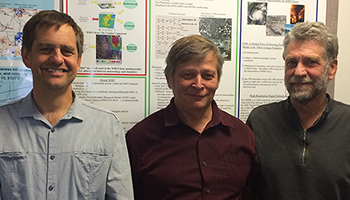A .gov website belongs to an official government organization in the United States.
A lock () or https:// means you've safely connected to the .gov website. Share sensitive information only on official, secure websites.
24 October 2016

Dr. Georg Grell of the Global Systems Division (GSD) and Dr. Stuart McKeen and Dr. Gregory Frost of the Chemical Sciences Division (CSD) of NOAA's Earth System Research Laboratory (ESRL) in Boulder, Colorado have been awarded the 2016 Haagen-Smit Prize. The Haagen-Smit Prize recognizes outstanding papers published in the journal Atmospheric Environment.
Grell, McKeen and Frost were authors on a 2005 paper entitled Fully coupled 'online' chemistry within the WRF model. The fact that their paper was published in 2005 and was selected for this prestigious prize in 2016 shows its long-term influence in the field.
The simulation and prediction of air quality involves meteorological factors such as wind speedand direction, turbulence, radiation, clouds, and precipitation, and chemical processes such as deposition, and transformation. Historically, these complicated factors forced modeling systems to treat air quality and meteorology independently, known as 'offline.'
In this paper, the researchers describe how they integrated chemical processes into the existing Weather Research and Forecasting (WRF) model making it fully coupled and 'online.' The "WRF-Chem" air quality and meteorological components are consistent with each other and use the same transport scheme, the same grid, and the same physics schemes for subgrid-scale transport.
The 2005 paper also compared the WRF-Chem Model output with previous chemistry models and found it to be just as accurate in predicting photochemistry and emissions as previous models, while providing better forecasts of ozone and ozone precursors. Since the paper's publication in 2005, the WRF-Chem model has become the standard for research in air quality as well as research on impacts of aerosol and chemistry on numerical weather prediction. WRF-Chem is now a community model – support provided by GSD – and has more than 2000 users worldwide.
The Haagen-Smit Prize is named in honor of Prof. Arie Jan Haagen-Smit, a pioneer in the field of air pollution and one of the first editors of the International Journal of Air Pollution, which proceeded Atmospheric Environment. Experts in the field submit nominations of previously published papers, and an international committee selects two winning papers each year.
Georg A. Grell, Steven E. Peckham, Rainer Schmitz, Stuart A.McKeen, Gregory Frost, William C. Skamarock, Brian Edere, Fully coupled 'online' chemistry within the WRF model, Atmospheric Environment, doi:10.1016/j.atmosenv.2005.04.027, 2005.
A fully coupled 'online' Weather Research and Forecasting/Chemistry (WRF/Chem) model has been developed. The air quality component of the model is fully consistent with the meteorological component; both components use the same transport scheme (mass and scalar preserving), the same grid (horizontal and vertical components), and the same physics schemes for subgrid-scale transport. The components also use the same timestep, hence no temporal interpolation is needed. The chemistry package consists of dry deposition ("flux-resistance" method), biogenic emission as in [Simpson et al., 1995. Journal of Geophysical Research 100D, 22875–22890; Guenther et al., 1994. Atmospheric Environment 28, 1197–1210], the chemical mechanism from RADM2, a complex photolysis scheme (Madronich scheme coupled with hydrometeors), and a state of the art aerosol module (MADE/SORGAM aerosol parameterization).
The WRF/Chem model is statistically evaluated and compared to MM5/Chem and to detailed photochemical data collected during the summer 2002 NEAQS field study. It is shown that the WRF/Chem model is statistically better skilled in forecasting O3 than MM5/Chem, with no appreciable differences between models in terms of bias with the observations. Furthermore, the WRF/Chem model consistently exhibits better skill at forecasting the O3 precursors CO and NOy at all of the surface sites. However, the WRF/Chem model biases of these precursors and of other gas-phase species are persistently higher than for MM5/Chem, and are most often biased high compared to observations. Finally, we show that the impact of other basic model assumptions on these same statistics can be much larger than the differences caused by model differences. An example showing the sensitivity of various statistical measures with respect to the treatment of biogenic volatile organic compounds emissions illustrates this impact.